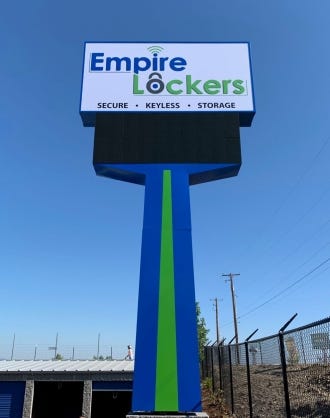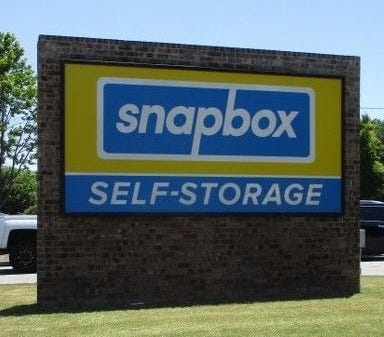Signage is a critical component of every self-storage facility, but if it isn’t properly cared for, it sends the entirely wrong message to prospective and current customers. Follow these tips to maintain your interior and exterior signs and ensure you get the most life and function out of this sizable investment.
August 24, 2022

Signage is an important component of every self-storage facility. Operators invest significant sums to ensure it represents their company and properly communicates with prospective and current tenants. But if it isn’t well cared for, it sends the entirely wrong message. That’s why regular maintenance shouldn’t be overlooked.
Your signs serve as a brand manager for your business. They’re a must-have marketing tool for any commercial or retail establishment, greeting customers and providing a professional first impression. But if your signs are dirty, damaged, neglected or out-of-date, that initial impression can quickly turn negative. Preventive maintenance helps protect your reputation. It also ensures you get as many years of service out of your signage as possible, increasing your initial return on investment.
Let’s look at the types of signage commonly used in self-storage and the best ways to care for it.

Empire Lockers in Medford, Oregon
Signage Types
Self-storage operators use signs of all types to convey messages, whether it’s to broadcast the company’s brand or provide customers with various instructions. Signage used inside the management office and storage buildings are primarily constructed of resin, acrylic or vinyl. These can include:
Lobby and office directories
Window and wall graphics
Braille and other signage that complies with the American With Disabilities Act
Wayfinding signs
Outdoor signs have to be able to withstand variable weather, particularly when they’re in environments that experience extremes in temperature and precipitation. These are typically made of aluminum, fiberglass, high-density urethane or stainless steel. Examples include:
Building signs
Channel letters
Property directories
Monument signs (ground-level signage designed to catch drivers’ eyes)
Illuminated signs
Caring for Your Signs
Always follow the cleaning instructions provided by your sign manufacturer. Nobody knows better than this company the materials and methods used to make each product. It’s therefore in the best position to advise you on the safest, most effective methods to care for your investment. Even if you don’t have access to the manufacturer’s instructions, the following simple tips will help keep your signs looking terrific for as long as possible.
Remove the wrapping. When you get a new sign, it’s generally wrapped in a protective covering to secure it in transit. Remove this immediately, as it can actually damage the surface when exposed to certain elements.
Set a schedule. All signs should be cleaned at least every three months. By setting a schedule and sticking to it, the task will require only a few minutes to complete, as dirt won’t have time to settle in.
Keep them clean. Interior signs should be wiped gently with a clean, soft, cotton cloth. You can also use canned air to safely remove dust and debris. If this isn’t sufficient, you can make a cleaning solution using a mixture of mild dish soap and water. Wipe the sign gently with a soft, clean, damp cloth (not soaking wet) and follow up with a clean, dry cloth. Work one small area at a time. Don’t leave any moisture! Also, never scrub the surface where the lettering appears.

Snapbox Self-Storage in Lawrenceville, Georgia
Exterior signage constructed from aluminum, fiberglass or acrylic should be cleaned using a car shampoo with wax, which preserves and protects the painted surface.
When necessary, use graffiti remover. This specially formulated product works well on various surfaces—provided it’s used correctly. Here are a few things to keep in mind:
Don’t use it in direct sunlight.
Before applying it to the entire sign, test it on an area that isn’t visible.
Use a soft cloth, and make sure the area is kept wet the entire time you’re cleaning.
Rinse with cold water.
Avoid applying graffiti remover to vinyl text, as it can damage the surface.
Use caution. Be extra careful on any signs with raised lettering or graphics. These should only be placed in climate-controlled areas and must not be exposed to high humidity or moisture. If this kind of sign gets wet, blot it dry immediately to avoid damage.
In addition, there are certain materials that should never be used to clean your signage, such as:
Abrasive sponges, cloths or scrub brushes
Detergent with ammonia or abrasives
Acids, solvents or methylated spirits
High-pressure washer
Squeegee
Razor blades
Any cloth used for other cleaning applications that may have come in contact with harmful chemicals
Note: If you're trying to clean vehicle wraps and graphics, use extra care to avoid damage to the substrate.
Pay attention to environmental factors. If your self-storage facility is in an industrial area, you may need to clean your exterior signs more often. Airborne pollutants like lime, sulfur dioxide and oil-based deposits can wreak havoc on the surface. Other elements that can impact signs include:
Foliage and tree resin
Bird droppings
Salt coupled with high humidity (coastal areas)
Harmful UV rays
Protect the base. When installing exterior signs with posts, position native plants around the bottom. This can help protect the post and base from damage by landscaping crews who might clip the sign with mowing equipment.
Check for damage. Regularly checking your self-storage signs for damage and malfunctions should be a customary part of your site-maintenance program. Though you may be tempted to fix a damaged or broken sign, it isn’t generally recommended. For things like changing out light bulbs and replacing lettering, it’s best to work with a professional sign company that has the equipment and know-how to create a seamless fix.

SecureStore Self Storage in West Virginia
Plan for Replacement
No matter how well you care for a sign, at some point, it’s time to say good-bye. Over time, even the best-maintained signage will fall victim to hazardous environments, severe weather and old age. Once the colors or graphics begin to fade, don’t wait until your message is unreadable before planning for replacement. Give yourself and your vendor partner plenty of time to create and install new signage before your current ones are totally worn out.
Considering how impactful signage can be for your self-storage operation, maintenance is a must. Showing pride in your establishment reflects well on the business and will be appreciated by employees as well as customers.
Steven Weber is head of self-storage sales for Blink Signs, a full-service company that provides permitting, fabrication, installation and servicing for exterior and interior signage. For the last five years, he’s helped self-storage owners nationwide with signage and branding needs from concept to completion. To reach him, call 877.433.4466; email [email protected].
About the Author(s)
You May Also Like





